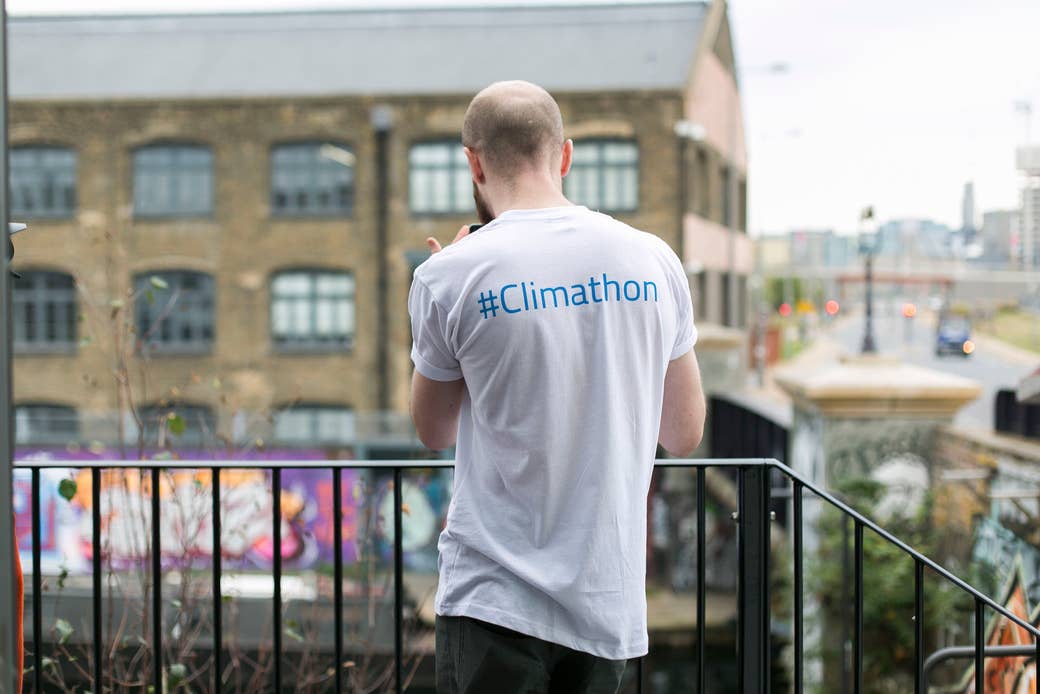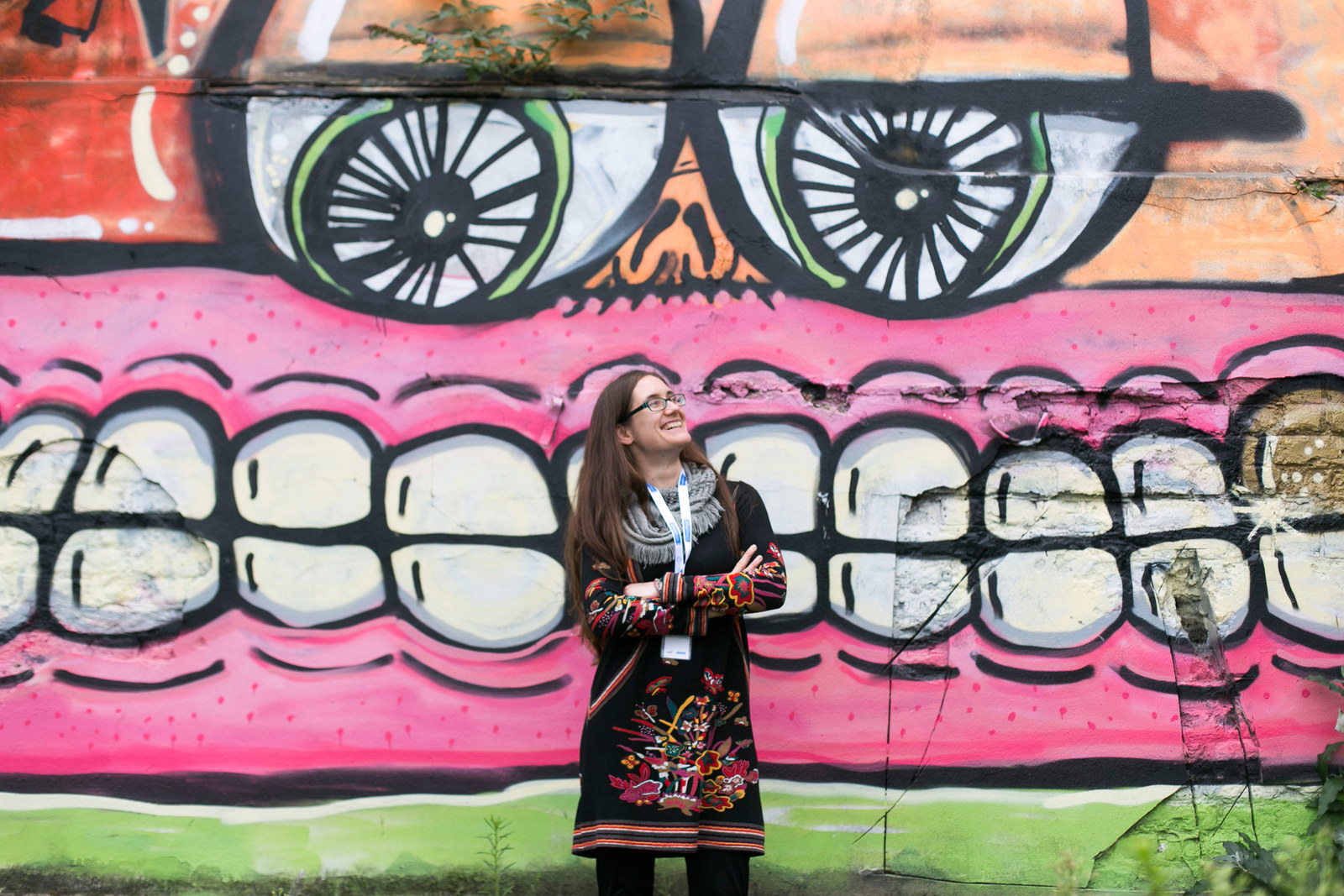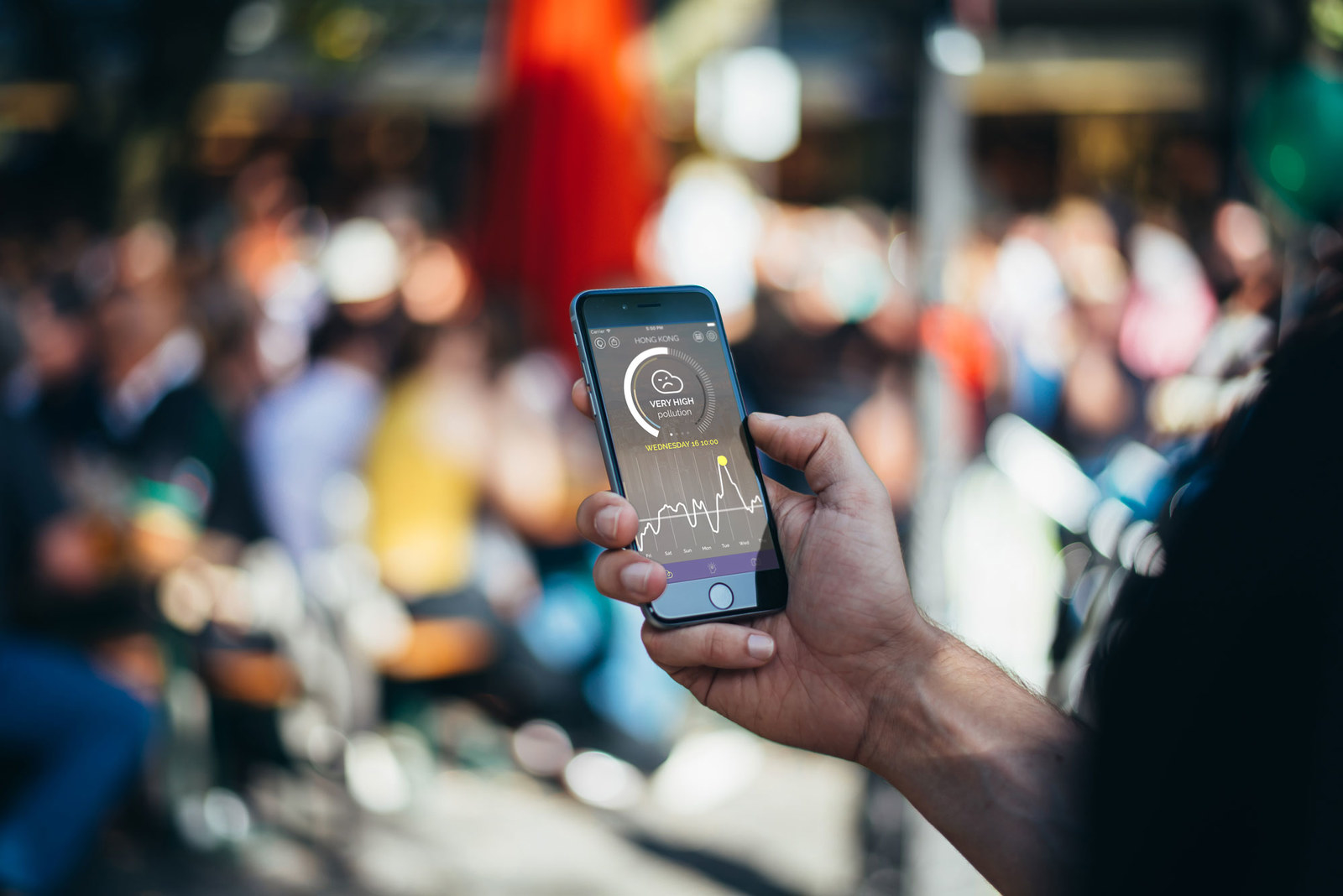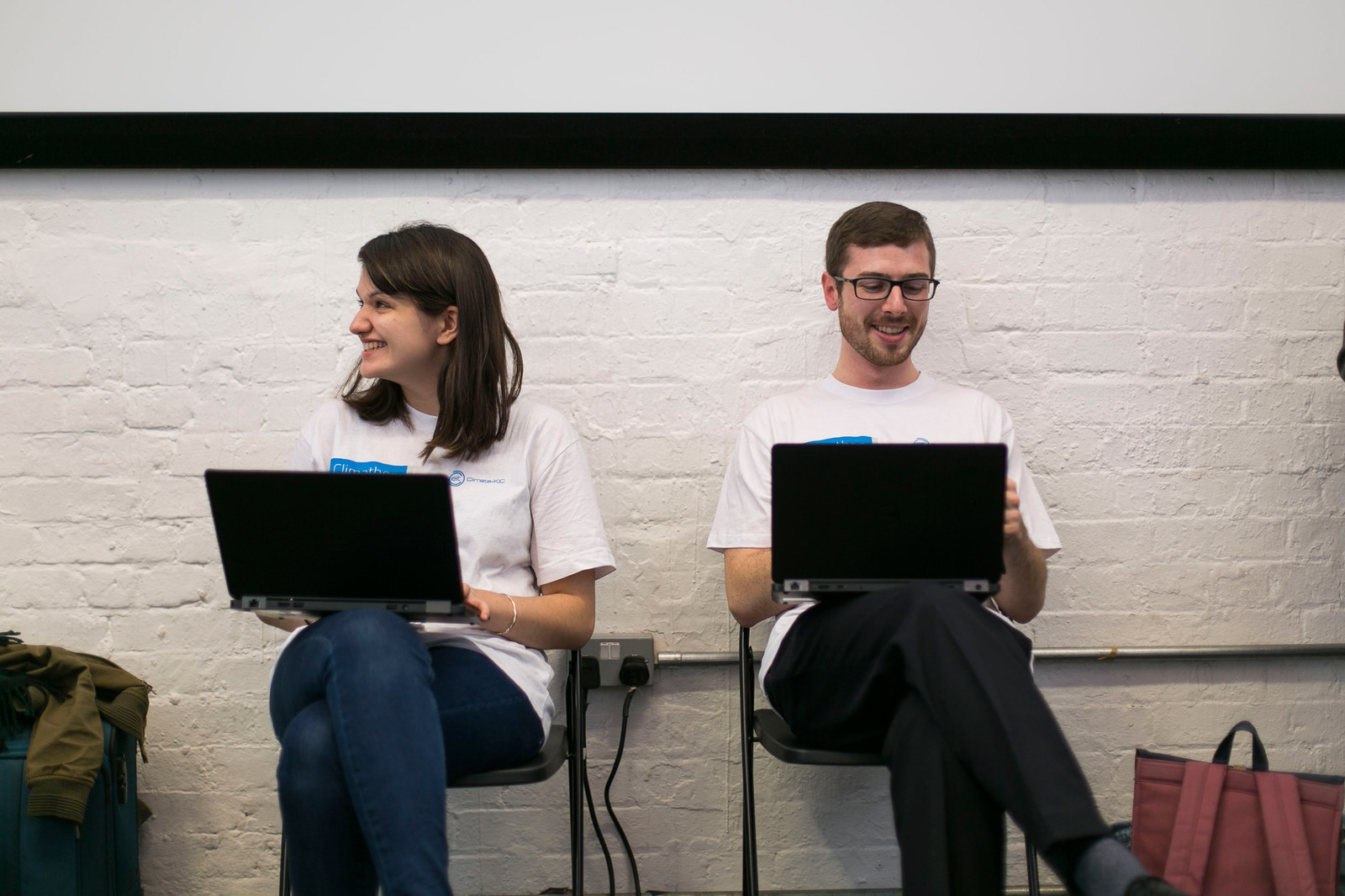Just a few days into this year, on 4 January, London’s Oxford Street breached the safe annual limit set by the EU for one type of air pollution. It’s estimated that air pollution contributes to 40,000 early deaths in the UK and costs more than £20 billion each year. And last week, the high court ruled that the government’s plans for tackling bad air quality are “illegally poor”.
In short, the UK – and London in particular – has an air pollution problem. One cloudy, autumnal afternoon, in a room above an east London microbrewery a stone’s throw from the Olympic Park, a group of students, experts, and other interested parties were gathered to try to solve it. They had 24 hours.

The 2016 London Climathon event, run by European climate innovation body Climate-KIC, was part of a series of climate-based hackathon-style events that run all over the world on the same day. At the end of each city’s 24-hour challenge, teams present their ideas to the room, and judges choose a winner.
This year over 120 cities in 36 countries across six continents took part, and each city chose a topic close to its heart. It’s not hard to see why the London organisers chose air pollution.
Cities around the UK suffer from pollution created, in large part, by traffic. But London has it particularly bad because of its size and layout, with dense, busy roads responsible for a lot of pollutants in the air, and a bunch of tall buildings holding them in place.
Right now, if you wanted to know what the air quality was like outside, you could check the daily air quality forecast from the Met Office for an overall look at pollution levels in the UK.
But if you’re about to leave for work and want to know what the air pollution is like outside your door, a regional forecast is not much use. That’s where more localised forecasts come in, like the London Air project run by King’s College London. And there's the Plume Air Report app from Paris-based startup Plume Labs, which covers over 300 locations worldwide including most major UK cities, and gives a measure of how worried you should be about a particular pollutant.
These forecasts are based on readings from the hundred or so static air-quality monitors dotted around London; modelling was used to fill in the gaps between them. The static sensors measure the levels of four pollutants in the air: nitrogen dioxide (NO2), ozone (O3), PM10 particles, and PM2.5 particles.
Ozone
Ozone levels in London, Paris, and Beijing from 28 October to 1 November 2016, compared with yearly averages in each city. Data provided by Plume Labs.
Nitrogen dioxide comes from combustion. Ozone forms when sunlight shines on other chemicals in the air, so it tends to be a problem on sunny days and less of an issue when it’s cloudy. PM stands for particulate matter, and the numbers 2.5 and 10 refer to the diameter of the particles in micrometres. PM particles come from both traffic and industry, and in smaller amounts from other sources like homes with wood burners.
NO2
Nitrogen dioxide levels in London, Paris, and Beijing from 28 October to 1 November 2016, compared with yearly averages in each city. Data provided by Plume Labs.
PM10
Levels of the PM10 in London, Paris, and Beijing from 28 October to 1 November 2016, compared with yearly averages in each city. Data provided by Plume Labs.
PM2.5
Levels of PM2.5 in London, Paris, and Beijing from 28 October to 1 November 2016, compared with yearly averages in each city. Data provided by Plume Labs.
For the most part, humans are responsible for putting these pollutants into the air, but once they’re out there, the weather takes over and decides where they go. If it’s raining or windy, for example, they’ll be dispersed relatively quickly. But if it’s hot and there’s no breeze, the particles can build up to dangerous levels.

BuzzFeed News arrived at the Climathon just a few hours into the 24-hour challenge. Ideas to improve air quality being floated around at this stage ran the full gamut, with some teams discussing ways to get people to change their behaviour, others looking at ways to get rid of pollutants once they’re in the air, and still more considering how to get companies to use electric vehicles to reduce emissions in central London.
Louise Brent, a second-year geography student at the University of Southampton, said she came to the event because air quality is important to her: “I think it's going to be a massive issue in London, especially now with the confirmed third runway at Heathrow, and I think it's something not enough people talk about.”
Her team was working on ideas to remove pollutants from the air. “We're using the Olympic Park as our base to develop the idea and how we think it would fit in here. We want to attach it to lampposts. So if you imagine a lamppost with a cylinder around it, that'll be the surface, so when the [pollutants] hit, they will turn from gas to solid and then drop to the ground.”
Elizabeth Jackson was part of a team brainstorming ideas around reducing pollution from trucking. She is a studying for a master's in environmental technology.
“The biggest emitter of air pollutants is automobiles, so we're trying to develop an idea around that. Right now we're bouncing around ideas to do with trucking,” she said. “There's a lot of ideas out there to get one person to stop using their car – like bike or walk if you can, carpool. But a lot of what gets emitted comes from, for example, when you’re getting your groceries, they have to come in by truck somehow, and those trucks are emitting just as much if not more than your personal car.”
Checking a pollution forecast first thing in the morning, like you would a weather forecast, would seem unusual to most people in the UK. But it’s commonplace for those in countries where air pollution is a big issue, like China, Singapore, and India. This week, for example, Delhi’s chief minister announced that schools would be closed for three days and advised people to stay indoors as much as possible as levels of PM2.5 reached more than 90 times World Health Organisation safe levels.
“In places like Beijing and Shanghai it's become a daily habit,” Plume Labs co-founder David Lissmyr told BuzzFeed News. “Just like you would check your weather app, in China many people are checking the air report app in the morning first thing when they wake up. ‘Do I turn on my purifiers at home? Will the school be open?’ They are exposed to such levels that it really has an impact on their lives.”
People in western Europe and North America use Plume’s app to make decisions too, Lissmyr says, albeit on a different scale. “It's more people who go out for a run, who may or may not decide not go out for a run that day, but wait for the next day, and so on.”

There are several angles from which to attack bad air quality, but getting better data is one everyone seems to agree on. Our current monitoring methods can only give an overview – they can help you decide whether or not to go out and exercise today, for example, but they’re not granular enough to help you decide which streets to go down, and which to avoid.
“Modelling [used in current forecasting] does take into account traffic flow, weather, all sorts of things, but it can’t account for pollution hot spots that might occur by lots of traffic suddenly getting jammed up, or things like that,” said Hannah Gardiner, a member of the winning team from last year’s Climathon in London. “The model's not perfect. People know this – it’s something that gets talked about.”
Gardiner’s day job is working on citizen science projects for the London Sustainability Exchange. But after being part of the winning team at the Climathon, she co-founded a startup called Air Public with her team-mates. Their idea was to develop a mobile air quality sensor that could be used to obtain much more detailed air pollution data than is currently available, telling you which streets to avoid as you walk, cycle, or run around the city.
Plume Labs, whose current app gives a citywide hourly air pollution forecast, is working on mobile air-quality sensors too. Earlier this year, the startup placed mobile sensors in tiny backpacks, which were put on pigeons as a proof of concept. “What we know is that pollution varies a lot from one street to another depending on where you are, and to have more personal information we need more personal sensors, so that's where the Plume air sensor comes into the picture,” Lissmyr said. “Since you can't fly drones in London, why not fly pigeons?”
Soon they’ll be giving those mobile sensors to a group of people in London to clip onto their clothes or backpacks and wear around the city for a few months as a beta test. The sensor will link up to an app on their phone, where they’ll be able to see live pollution levels as they travel around the city. Plume plans to make a live map of air quality in London using the data collected, and will work with scientists from Imperial College London to analyse it and work out how it can best be used to help people lower their exposure to air pollution.
Getting this kind of granular data would allow policymakers to act much more quickly on air pollution than they currently can, trying out street-level interventions and then checking to see if they work. But it’ll also put power in the hands of people to make decisions about their own exposure to pollutants.

In the end, this year’s winning Climathon team’s idea was to put filters on London buses to reduce the number of pollutants being emitted into our air in the first place. The runners-up took a different strategy: They want to create a mesh cover to protect babies in prams from air pollution. It’s too early to know whether these or any other proposals from the day will come to fruition, but it’s clear that, as a city, London isn’t short on ideas for solving this crisis.
Better monitoring is one approach to tackle air pollution, but it can’t solve the problem by itself. "It's a broad issue with no single magic bullet," Tom Mitchell, Climate-KIC’s UK director, told BuzzFeed News.
“We need an open discussion about measurement and about sampling air in a way that gives people a bit more control over their lives, and gives them real-time data that allows them to make decisions about when they do and don't go out, where they do and don't walk,” Mitchell said. “But we also need to have a much more serious discussion about the future changes in the city that we need to see.”

